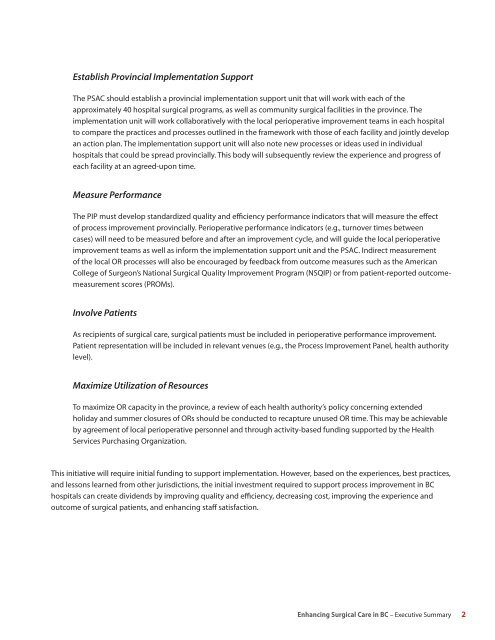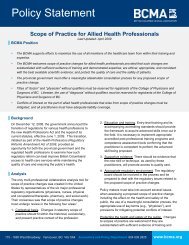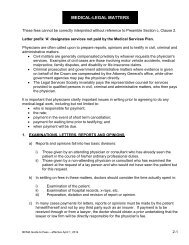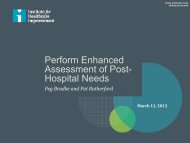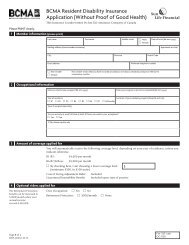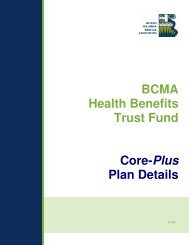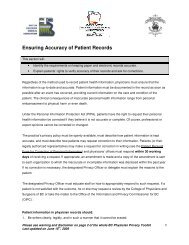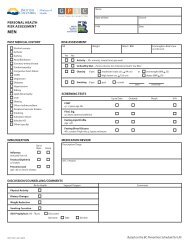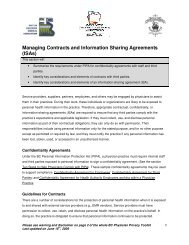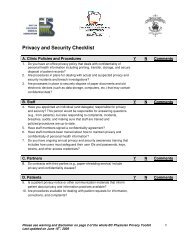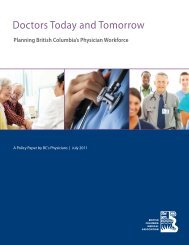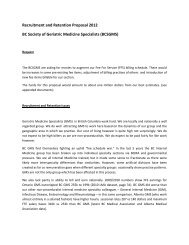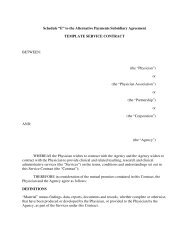Enhancing Surgical Care in BC - British Columbia Medical Association
Enhancing Surgical Care in BC - British Columbia Medical Association
Enhancing Surgical Care in BC - British Columbia Medical Association
You also want an ePaper? Increase the reach of your titles
YUMPU automatically turns print PDFs into web optimized ePapers that Google loves.
Establish Prov<strong>in</strong>cial Implementation Support<br />
The PSAC should establish a prov<strong>in</strong>cial implementation support unit that will work with each of the<br />
approximately 40 hospital surgical programs, as well as community surgical facilities <strong>in</strong> the prov<strong>in</strong>ce. The<br />
implementation unit will work collaboratively with the local perioperative improvement teams <strong>in</strong> each hospital<br />
to compare the practices and processes outl<strong>in</strong>ed <strong>in</strong> the framework with those of each facility and jo<strong>in</strong>tly develop<br />
an action plan. The implementation support unit will also note new processes or ideas used <strong>in</strong> <strong>in</strong>dividual<br />
hospitals that could be spread prov<strong>in</strong>cially. This body will subsequently review the experience and progress of<br />
each facility at an agreed-upon time.<br />
Measure Performance<br />
The PIP must develop standardized quality and efficiency performance <strong>in</strong>dicators that will measure the effect<br />
of process improvement prov<strong>in</strong>cially. Perioperative performance <strong>in</strong>dicators (e.g., turnover times between<br />
cases) will need to be measured before and after an improvement cycle, and will guide the local perioperative<br />
improvement teams as well as <strong>in</strong>form the implementation support unit and the PSAC. Indirect measurement<br />
of the local OR processes will also be encouraged by feedback from outcome measures such as the American<br />
College of Surgeon’s National <strong>Surgical</strong> Quality Improvement Program (NSQIP) or from patient-reported outcomemeasurement<br />
scores (PROMs).<br />
Involve Patients<br />
As recipients of surgical care, surgical patients must be <strong>in</strong>cluded <strong>in</strong> perioperative performance improvement.<br />
Patient representation will be <strong>in</strong>cluded <strong>in</strong> relevant venues (e.g., the Process Improvement Panel, health authority<br />
level).<br />
Maximize Utilization of Resources<br />
To maximize OR capacity <strong>in</strong> the prov<strong>in</strong>ce, a review of each health authority’s policy concern<strong>in</strong>g extended<br />
holiday and summer closures of ORs should be conducted to recapture unused OR time. This may be achievable<br />
by agreement of local perioperative personnel and through activity-based fund<strong>in</strong>g supported by the Health<br />
Services Purchas<strong>in</strong>g Organization.<br />
This <strong>in</strong>itiative will require <strong>in</strong>itial fund<strong>in</strong>g to support implementation. However, based on the experiences, best practices,<br />
and lessons learned from other jurisdictions, the <strong>in</strong>itial <strong>in</strong>vestment required to support process improvement <strong>in</strong> <strong>BC</strong><br />
hospitals can create dividends by improv<strong>in</strong>g quality and efficiency, decreas<strong>in</strong>g cost, improv<strong>in</strong>g the experience and<br />
outcome of surgical patients, and enhanc<strong>in</strong>g staff satisfaction.<br />
<strong>Enhanc<strong>in</strong>g</strong> <strong>Surgical</strong> <strong>Care</strong> <strong>in</strong> <strong>BC</strong> – Executive Summary 2


